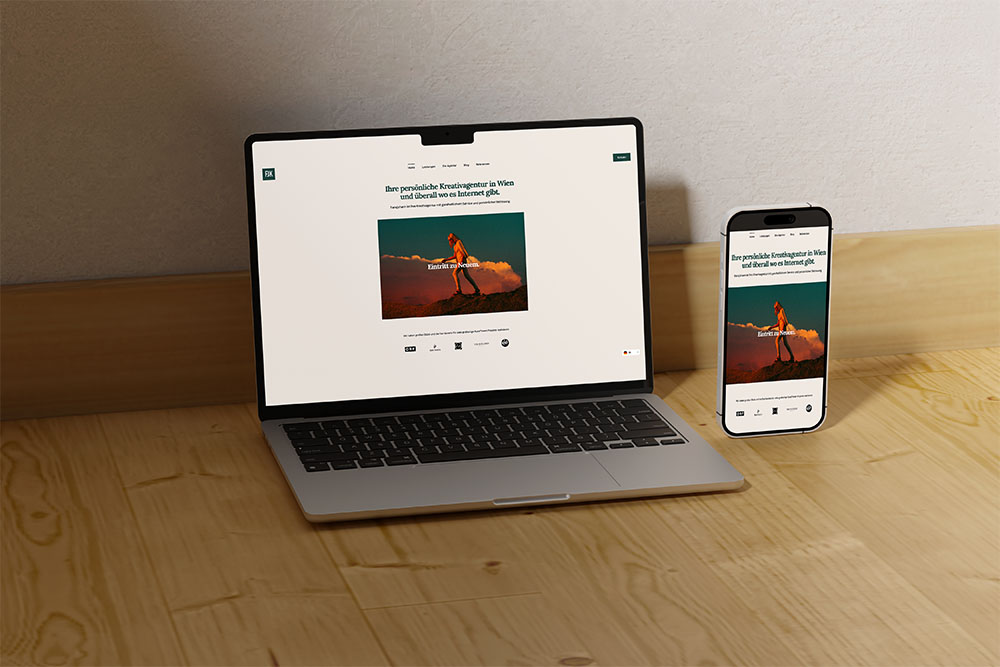Mobile first design: your website for mobile users
In a world where smartphones and mobile devices are our constant companions, mobile-first design has become an essential part of web development. The way people use the internet has changed dramatically. Statistics show that today more than half of internet users access web content exclusively via mobile devices. So if your website is not optimized for mobile devices, you are losing half of your potential audience.
"Since we implemented the "Mobile First Design" concept on our website with the help of franzjohann creative agency, our click-through rate on mobile devices has increased significantly. Our customers are thrilled with the fast and user-friendly experience." - Michael P.
Mobile First Design is much more than an option, it is a fundamental step in website design. Here are some key factors for a successful implementation.

We write about this in this blog post:
1. Responsive web design
Ensure that your website is displayed optimally on different screen sizes. Use CSS media queries to dynamically adapt layouts and content. The adaptability of a website to different devices is not only a question of aesthetics, but also of functionality. Users expect a smooth user experience, regardless of whether they are using a smartphone, tablet or desktop computer. A well-implemented responsive design increases user satisfaction and improves the SEO of your website. Search engines prefer mobile-optimized sites. You can find more information in our separate blog post: "Responsive web design - a must-have for every website."
2. improve speed of the website
Mobile users are impatient. Optimize the speed of your website by compressing images and videos and using caching techniques, for example. Loading speed is of great importance, as even a delay of a few seconds can lead to increased bounce rates. When optimizing media content, you should also consider minimizing HTTP requests, using content delivery networks (CDNs) and optimizing CSS and JavaScript files. A fast website not only improves the user experience, but also contributes positively to your search engine ranking. You can find more information on this in our separate blog post: "Improving the speed of your website - here's how!"
3. touch screen friendliness
Your website elements should be large enough and well separated to avoid accidental touches. Clear color contrasts are important, while hover effects should be avoided. It is equally important to design the mobile version of the website so that it can be navigated with just one finger. Designing for touchscreens requires careful planning of the user interface to ensure that all interaction elements are easily accessible and operable. This includes considering how users scroll, tap and swipe to navigate through your content.
Your website, our concern!
Start your online success story today! Let franzjohann Kreativagentur create your customized website and conquer the internet. Contact us now to take the first step towards digital success!
4. content prioritization
Mobile users are often looking for quick answers. It is therefore essential to focus on clear messages, an easy-to-understand structure and intuitive navigation. Superfluous elements should be reduced in order to shorten loading times. Regular content analysis is necessary to maintain relevant content and remove outdated content. Effective prioritization of content improves the user experience and reduces bounce rates. Mobile users want to act in a targeted manner.
5. tests and optimizations
Regular browser compatibility checks and device tests are essential to ensure consistent performance. The data obtained makes it possible to make adjustments. This leads to an improvement in the user experience and therefore also increases conversion rates. It is important to include a wide range of devices and browsers in your testing to ensure your website is accessible to all users. Use tools such as Google's Mobile-Friendly Test to check the mobile-friendliness of your site and identify potential issues.
In order to design your website optimally in terms of "mobile first design", several key factors must be taken into account. Responsive web design ensures that your website is displayed optimally on different screen sizes. Improving the speed of the website is crucial as mobile users are impatient. Compress images and videos and use caching techniques to optimize loading times. Touchscreen friendliness requires large, well-separated elements with clear color contrasts. Prioritizing content means focusing on clear messages and intuitive navigation, reducing superfluous elements and performing regular content analysis. Finally, testing and optimization are essential to ensure consistent performance across different browsers and devices to improve user experience and conversion rates.
Optimize now!
Contact us today and work with us on your personal "Mobile First Design" concept to optimize your new or existing website!
The franzjohann creative agency sees itself as a further development of the classic advertising agency. We realize projects while other agencies still want to sell you an onboarding workshop.

Let's start together!